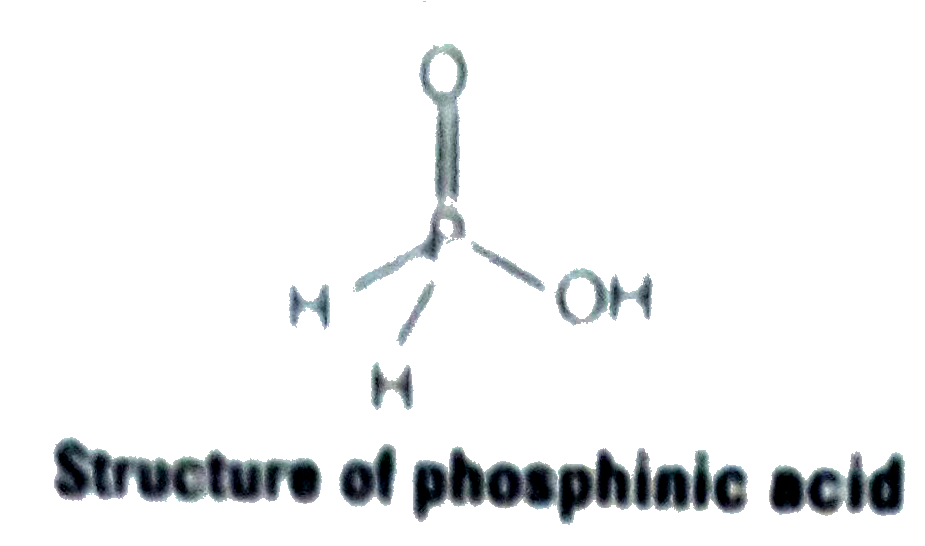Phosphorus forms a number of oxoacids. Out of these oxoacids, phosphinic acid has strong reducing property. Write its structure and also write a reaction its reducing behaviour.
Among various forms of oxoacids, phosphinic acid has stronger reducing property.

Reaction showing reducing behaviour of phosphinic acid is as follows
4AgNO3+2H2O+H3PO3→4Ag↓+4HNO3+H3PO4
Topper's Solved these Questions
- P-BLOCK ELEMENTSBook:NCERT EXEMPLAR ENGLISHChapter:P-BLOCK ELEMENTSExercise:Matching The Columns
Explore 5 Videos
- P-BLOCK ELEMENTSBook:NCERT EXEMPLAR ENGLISHChapter:P-BLOCK ELEMENTSExercise:Assertion and Reason
Explore 6 Videos
- HALOALKANES AND HALOARENESBook:NCERT EXEMPLAR ENGLISHChapter:HALOALKANES AND HALOARENESExercise:Long Answer Type Questions
Explore 3 Videos
- POLYMERBook:NCERT EXEMPLAR ENGLISHChapter:POLYMERExercise:Long Answer Type Question
Explore 5 Videos
Similar Questions
Write the structure of B2H6 and its reaction with HCl(excess).
View SolutionTake any one alkali metal and write its reaction with Acid
View SolutionPhosphorus forms a number of oxoacids which differ in their structures and oxidation state of phosphorus. All the acids contain phosphorus atom//atoms linked tetrahedrally to four other atoms or groups. Each of them has at least one P=O or P→O unit and one P−OH unit. The OH group is ionisable but H atom linked directly to P is non-ionisabl. Structures of all the acids are considered to be derived either from phosphorus acid or phosphoric acid.
Which of the following is a cycle oxoacid ?
View SolutionPhosphorus forms a number of oxoacids which differ in their structures and oxidation state of phosphorus. All the acids contain phosphorus atom//atoms linked tetrahedrally to four other atoms or groups. Each of them has at least one P=O or P→O unit and one P−OH unit. The OH group is ionisable but H atom linked directly to P is non-ionisabl. Structures of all the acids are considered to be derived either from phosphorus acid or phosphoric acid.
The acid which forms two series of salts is.
View SolutionPhosphorus forms a number of oxoacids which differ in their structures and oxidation state of phosphorus. All the acids contain phosphorus atom//atoms linked tetrahedrally to four other atoms or groups. Each of them has at least one P=O or P→O unit and one P−OH unit. The OH group is ionisable but H atom linked directly to P is non-ionisabl. Structures of all the acids are considered to be derived either from phosphorus acid or phosphoric acid.
Which one has +3 oxidation state ?
View SolutionPhosphorus forms a number of oxoacids which differ in their structures and oxidation state of phosphorus. All the acids contain phosphorus atom//atoms linked tetrahedrally to four other atoms or groups. Each of them has at least one P=O or P→O unit and one P−OH unit. The OH group is ionisable but H atom linked directly to P is non-ionisabl. Structures of all the acids are considered to be derived either from phosphorus acid or phosphoric acid.
Which one is monobasic acid ?
View SolutionPhosphorus forms a number of oxoacids which differ in their structures and oxidation state of phosphorus. All the acids contain phosphorus atom//atoms linked tetrahedrally to four other atoms or groups. Each of them has at least one P=O or P→O unit and one P−OH unit. The OH group is ionisable but H atom linked directly to P is non-ionisabl. Structures of all the acids are considered to be derived either from phosphorus acid or phosphoric acid.
The number of or P=O and P−O−H bonds in H3PO4 are.
View Solutionp-block elements form acidic, basic and amphoteric oxides. Explain each property by giving two examples, and also write the reactions of these oxides with water.
View SolutionEthene forms an addition product with chlorine. Name this addition product and write its structural formula.
View SolutionIn acidic medium ,H2O2 acts as a reducing agent in its reaction with :
View Solution